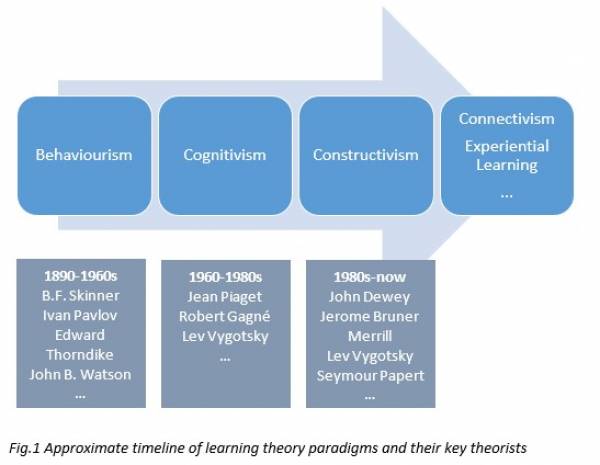M02-2: Learning Theories
Learning theories seek to understand how humans learn. There are different learning theories: “classical” ones such as behaviorism, cognitivism, constructivism, and newer ones such as connectivism or experiential learning and many more (Fig. 1). Since they represent different paradigms, they each have a different outlook on what knowledge actually is and what makes learning “successful”.
Although there are many different learning paradigms (see for example UNESCO), we will now deal with three dominating theories of knowledge acquisition (behaviorism, cognitivism and constructivism) that allow you to understand the process of learning - and finally also of teaching - in more detail.
Learning Theories are frequently applied in teaching. See some examples here:
This table illustrates some key aspects of each learning theory. For deeper information, also check the links in the headlines of Tab. 1:
| Behaviorism | Cognitivism | Constructivism | |
| View of knowledge | Knowledge is a repertoire of behavioral responses to environmental stimuli. | Knowledge systems of cognitive structures are acquired through instruction and constructed by learners based on pre-existing cognitive structures. | Knowledge is constructed within social contexts through interactions with a knowledge community. |
| View of Learning | Passive absorption of a predefined body of knowledge by the learner. Promoted by repetition and positive reinforcement. | Assimilation and accommodation of new information to existing cognitive structures. Integration of students into a knowledge community. | Collaborative assimilation and accommodation of new information. |
| Learning results | Stimulus-response-connection | Abstract and generalizable knowledge (e.g. competencies, problem-solving etc.) | Contextualized knowledge, applicable knowledge for specific situations |
| Implications for teaching Correct behavioral responses are transmitted by the teacher and absorbed by the students. | The teacher instructs and facilitates learning by providing an environment that promotes discovery and assimilation/ accommodation | Collaborative learning is facilitated and guided by the teacher. Group work is encouraged. | |
| Learning Design | Dividing content into smaller sections/units | Adapting learning materials to learners` conditions | Integration of learning and real-world contexts, Material is authentic, situated |
| Key methods | Sequential, prepared and structured exposure to content | Exposure to and exploration of content | Exploration, project-work, cooperative learning |
| Control of learning process | Teacher-centred, learner passive | Teacher-centred instruction, learner-centred depending on learning progress Learner-centred | |
| Control of learning outcome | Regularly at every step of the way, necessary in order to adapt learning opprtunities | Regularly after complete learning units, at best integrated in learning tasks | For own diagnosis, application-oriented exercises, to create a record of learning processes |
| Role of media | Controlling and regulating the learning process | Presentation of knowledge, interactivity, adaptivity | Offering opportunities to learn (collaboratively) in joint knowledge construction |
Tab. 1 Learning theories (adapted and translated from Kerres 2013, 147; adapted from Berkeley Graduate Division: Overview of Learning Theories)
Literature
Kerres, Michael (2013). Mediendidaktik. Konzeption und Entwicklung mediengestützter Lernangebote. 4. Auflage. München: Oldenbourg Verlag.

